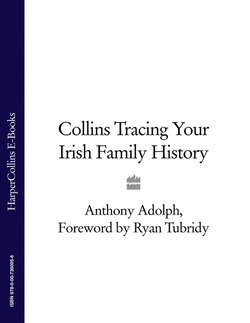Читать книгу Collins Tracing Your Irish Family History - Ryan Tubridy, Anthony Adolph - Страница 27
Religious registers
ОглавлениеReligious registers are also called church registers and parish registers. Parishes were fixed geographical units, in which priests kept registers. However, registers were also kept by priests on the move – on wagon trains crossing 19th-century America, or moving furtively amongst scattered communities of persecuted Catholics in 17th-century England.
Some denominations recorded births, but you will generally find baptisms, marriages and burials. The records are often slightly less detailed than Civil Registration, but not always – many Catholic and Quaker registers, for example, can sometimes be even more informative. They can be used in a similar way to Civil Records. Many people start using them for the period before Civil Records. Actually, there are cases where it is sensible to seek both types of record. An Irish civil marriage, for example, will state the father’s name, whereas the corresponding Catholic one may give the mother’s too.
Baptism records usually state the child’s name, date of baptism, father’s name and mother’s forename. You may get less (16th-century English baptisms sometimes omit parents’ names altogether) or more, such as date of birth, father’s occupation and mother’s maiden name. It’s worth finding out what information registers are likely to contain before searching them, to ensure the level of detail matches your needs.
Especially with Catholic records, baptisms will give the names of the godparents (also called ‘gossips’ or ‘sponsors’). These were people undertaking to look after the child’s physical and spiritual needs should the parents die. Sometimes, they might be powerful patrons – the family’s landlord, employer or a distant, rich relative. Usually, though, they were close friends, relatives and neighbours. It therefore makes sense to find the baptisms of all the family’s children, for the godparents’ names will build up a picture of the wider ties of kith and kin.
If the baptism record tells you both parents’ full names, you can seek their marriage with confidence. If it just states the mother’s forename, then you must seek the marriage ‘blind’, looking, for example, for any Thomas O’Briens marrying a Joanna. If you find Thomas O’Brien marrying Joanna O’Flynn, you won’t know for sure that this is the right wedding. You therefore need to make fairly broad searches, to make sure there are no other possibilities, and look for any other pointers that will help decide. If occupations and places of residence are known, for example, you can see if these match up. And you may recognise names from the list of the next generation’s godparents. There are no hard and fast rules, and you seldom get 100 per cent proof – your aim, though, is to seek as high a percentage of proof as you can.
Some baptism registers state dates of birth, but many don’t. Most children were baptised soon after birth: infant mortality was very high, and an unbaptised child could not enter Heaven. However, for many reasons, such as practical difficulties or religious indifference, it could take weeks, months or years for parents to present their children to the font. So never record a date of baptism as a birthdate, and when looking for someone born in 1810, you may need to search several years or more further forward before finding a baptism.
Some marriage registers give parents’ names, sometimes in full, whilst others just name the fathers. The burial registers usually just state the name, date and age – thus indicating when people were born: occupations and places of residence sometimes appear.
A useful finding aid is www.familysearch.org. Compiled by the Mormons, it is an index to many baptism and marriage registers. It is by no means complete: not all existing registers are indexed (its coverage of Catholic registers is relatively low) and some of the registers included have only been partially indexed. Therefore, you will not always find your family here, and finding someone of the right name in FamilySearch does not automatically mean it’s the right person! Nonetheless, it is a formidable tool, always worth checking, and if you find what appear to be the right people, always check the original registers from which the index references came.
Associated with burial records are gravestones. These often mention more than one member of the family (‘…beloved wife of X’, for example) but their great use in Irish genealogy is that migrants’ graves sometimes state the place of origin. Many gravestone inscriptions have been transcribed and these are available in archives or on the Internet.
